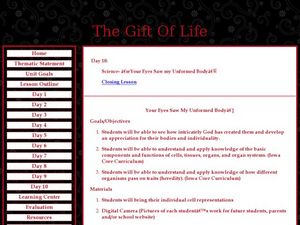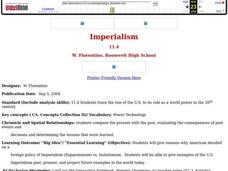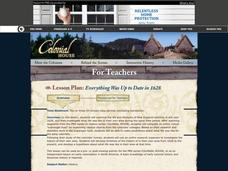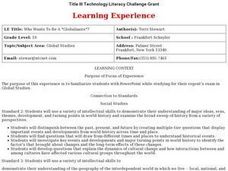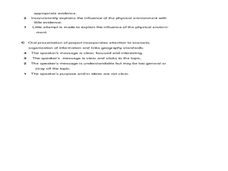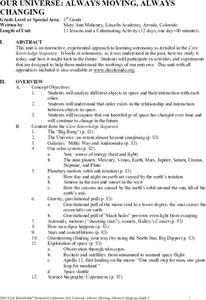Curated OER
The Lansing Old Stars Trading Card Collection
Learners study about the first people that came to the Lansing area. After reading a series of stories students have gained an examineing of how people in the 1800s and 1900s dressed. They design trading cards to portray their settler...
Curated OER
What's Russia To Do?
Students watch a PowerPoint presentation on the Gulag system in Russia. In groups, they use the internet to create maps on climate and population pyramids for the country of Russia. They must use this information and develop a plan to...
Curated OER
Jazz in America
Students explore the Jazz of today and its future. They answer questions and listen to music.
Curated OER
Using Metaphors
Learners rewrite seven sentences using a metaphor to express the concept presented literally in the originals. One example is provided. What I like here is that the sentences presented fuel thinking about comparisons to support kids'...
Curated OER
Get the Drift?
The anticipatory set is clever: give groups five minutes to work on the puzzle and then discuss what strategies they used to match the few that connected. This introduces middle schoolers to the concept of continental drift. A portion of...
Curated OER
Who was affected by North American Colonization and How?
Conduct research on various aspects of American Colonization and explore how different groups were affected, including those involved in the Salem Witch Trials. Your class will read books, write journals, participate in class discussion,...
Curated OER
Your Eyes Saw My Unformed Body: closing lesson
For those who teach and believe in Intelligent Design, this lesson is perfect. Religion learners read and discuss Psalm 139: 1-18, and present their cell representation in class. They then watch a speech by Louie Giglio about the protein...
Curated OER
My Community: Then and Now
Students compare and contrast their community to what it was like 50 years ago. They research various aspects of their community and compare and contrast with what it is like now. Students present and discuss their findings.
Curated OER
Down on the Farm
Students are introduced to a map of an Illinois farm. They determine whether the map is of the past, present, or future by looking at features on the map. They also use the map to make a three-dimensional model.
Curated OER
Adventures along the Oregon Trail in Nebraska
Students discover how the land and people we develop relationships with in Nebraska affect our survival--past, present, and future. They write about and interview their grandparents, parents and peers and compare them with people on the...
Curated OER
Comprehension: Setting
Young scholars discuss what setting represents. In this language arts lesson plan, students review the three elements of setting: where the story takes place, when does the story take place, and is it past, present, or future? Young...
Curated OER
Transportation and Mapping
Students view murals that depict various modes of transportation. They discuss the importance of maps to navigation and create a map. They compare and contrast transportation of the past with modes of transportation used today.
Curated OER
Imperialism
Learners explore the concept of Imperialism. In this foreign policy lesson, students examine the policies of the US and other countries through time. Learners then create a political cartoon of their own and create a timeline that...
Curated OER
Everything Was Up to Date in 1628
Students examine the life and lifestyles of New England colonists in the year 1628, and then investigate what life was like in their own area during the same time period. After watching segments from the PBS history series, "Colonial...
Curated OER
Who Wants To Be A "Globalnaire"?
Tenth graders research geography and the process of creating a Powerpoint presentation. In pairs, they design their own game show, writing geography questions, and creating a Powerpoint presentation for other students to play their game.
Curated OER
Invention Timeline
In this lesson, students Create a timeline of historical events, Identify patterns of change, Interpret data in a timeline.In this lesson, students use Inspiration to view progress over time as they develop
timelines highlighting...
Curated OER
Early American Portraits: a Strategy for Learning About Artists and Their Works
Students study artworks from several different artists. They compare and contrast these works and examine the historical background of the artist and his or her times.
They develop the capacity to think critically and communicate their...
Curated OER
Verb Conjugation Practice
In this verbs worksheet, students read the information and learn to conjugate a verb into six tenses. Students then conjugate five verbs into present, past, future, present perfect, past perfect and future perfect tense.
Curated OER
Mexican-Americans: Yesterday, Today and Tomorrow
Students examine how the Mexican-American culture developed in Los Angeles. They explore the past, present and future of Mexican-Americans in LA and present their findings in a PowerPoint presentation.
Curated OER
Growth in A City Neighborhood
Young scholars take the "role" of city planner. They overlay a map of one area of the city in the past, present, and projected future project. Students discuss reasons for selecting the special features of the area. The lesson refers...
Curated OER
Our Universe: Always Moving, Always Changing
Students explore the main concepts of astronomy through the eleven lessons of this unit. The past, present, and future methods of studying the science are examined in this unit.
Curated OER
The Moving Continents from Pangaea to the Future
Eighth graders examine how the movements of the Earth contribute to fossil distribution. In this fossils lesson students make maps of the placement of the continents.
Curated OER
Transportation Through Time
Third graders measure the speed at which they can walk in order to understand speed and distance traveled. They then research the history of transportation and express data in a class timeline.
Curated OER
Sometimes and All the Time Foods
Students recognize a wide variety of fruit and have a greater understanding about the importance of fruit in their diet, and determine that some fruits' skins are edible and others are not.






